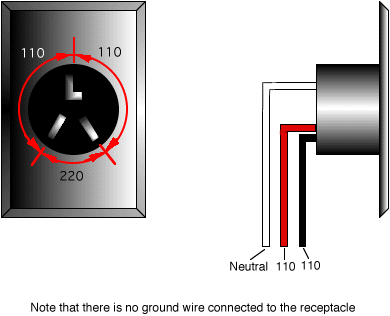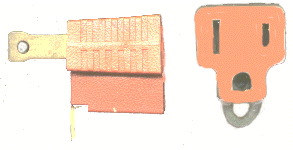
This section covers the principles of electric wiring in traditional and mobile homes. The two 110 volt circuits coming from the power company's distribution system and going to a breaker box and finally, fanning out to many individual circuits in your home will be addressed in the following subtopics.
All power companies use an alternating current transmission scheme with long range transmission voltages sometimes in excess of 100,000 volts. The voltage phase changes 60 times per second and facilitates the use of transformers to step the voltage down at substations for local distribution and one more drop before it enters your home as two 110 volt circuits.
Power is brought down from the high voltage transmission towers to substation transformers. Substation transformers lower the voltage for local distribution via power poles. The power pole line can come all the way to your home or be converted to an underground distribution system for the final leg to your house. Another transformer steps the voltage down to the two 110 volt circuits, plus a neutral wire, to your house.

The power meter is much like the water meter in line with the water coming into your house. The power meter is in line with the power feed from your nearest transformer. The power meter is read by the your local power company's meter reader and displays the amount of power you use each month. The power is measured in kiloWatt-hours. The Watt is the unit of electrical energy. One kiloWatt-hour is equivalent to the use of 1000 Watts of electricity (ten 100-Watt bulbs) for one hour. A kiloWatt-hour typically costs from 7 to 10 cents.
A load center is positioned between a breaker box and the power meter. They are located near the power meter and therefore are frequently found in your garage. The load center has one big breaker for each of the 115 volt circuits from the power meter. A typical main breaker in a load center is 150 amperes (amps).
The two primary 115 volt power feeds from the power meter or the load center are routed into the breaker box for distribution into your home as power circuits.

The two power feeds are connected to two power buses located behind the circuit breakers. Note the lower left hand breakers in the diagram above (pink 30-amp ganged breakers). The top breaker, with the black wire leading to it, is connected to one 115 volt bus and the bottom breaker, with the red wire leading to it, is connected to the other 115 volt bus. The third white wire is connected to the neutral bus which in turn was connected to the center tap on the power company's transformer and to a ground rod outside.
If we follow the dryer circuit out from the breaker box to the utility room, the wires are connected to the dryer wall plug as follows:

Now let's take a look at the wall outlet circuit that starts with the black wire leading down from the top left 20-amp breaker in the breaker box image above. This is a single 115 volt circuit that will service 2 or 3 wall outlets. The white wire is connected to the common neutral bus. But for this circuit we have a copper ground wire that is connected to the common neutral bus and to the ground bus leading out to a ground rod. If we follow this wall outlet circuit out to a duplex wall outlet, it will be wired up as follows:

Take a close look at the picture of the duplex outlet above. Note that the vertical slot to the left is longer than the one to the right. This is an attempt to polarize the outlet so that things like a lamp will not have the hot wire on the sleeve section of the light bulb which would make it a greater shock hazard. IF the outlet is wired properly, the white wire is connected to the longer neutral slot to the left and the hot black wire is connected to the short slot to the right. One of the lamp cord plug blades is wider than the other and insures that the neutral and hot wires go to the right places.
How about a plug with a ground lug on it? The first thing to notice is that the ground lug polarizes the plug because there is only one way to plug it in. Therefore there is no need to have a wide and a narrow blade. However, it's still possible to wire the outlet wrong. This is where the safety ground comes into play. If the outer case of an appliance is always connected to the safety ground it doesn't make much difference what happens to the other two wires. If the neutral wire shorts to the case nothing happens. If the hot wire shorts to the case, a short circuit is presented to the breaker and it should open. The safety ground prevents YOU from being the path for a circuit from a hot wire shorted to the case to ground.
Scroll back to the circuit breaker drawing and note that the bare copper safety wires and the white insulated wires come together on busses that are both connected to an external ground rod. The safety ground is sometimes called the "grounding conductor". The white neutral wire carries current for each circuit and is therefore called the "grounded conductor".
Older homes are wired with duplex outlets that lack the safety ground lugs. So what do you do if you have an appliance like a refrigerator that has a plug with a safety ground lug on it and you need to plug it into one of these old outlets? Sure, you use one of those nifty adapter things like the one shown below:

So, you slapped the adapter on the end of the refrigerator plug, plugged it in and it worked fine. But let's take a look at what you just did. The safety ground lug that you just defeated was connected to the outer metal shell of the refrigerator. A refrigerator has two types of heaters just under the skin - mullen heaters to keep the door seals from freezing onto the metal and shell heaters to keep the metal shell from sweating in humid surroundings. If the insulation on these heaters breaks down in the presense of water and you put your hand on the refrigerator, you will have a tingling sensation in your hand as electrical current flows through your body. Standing barefoot in water will increase the tingling to a stout jolt.